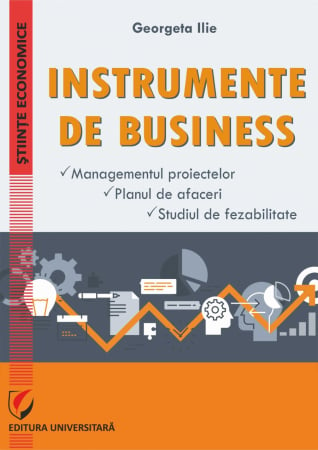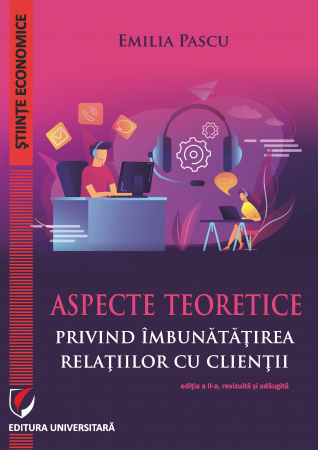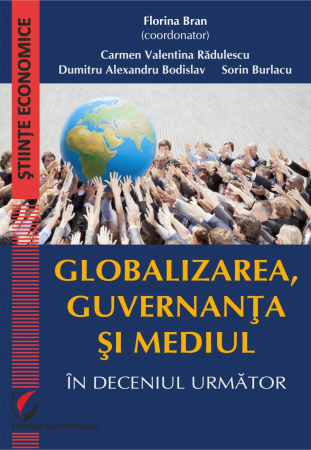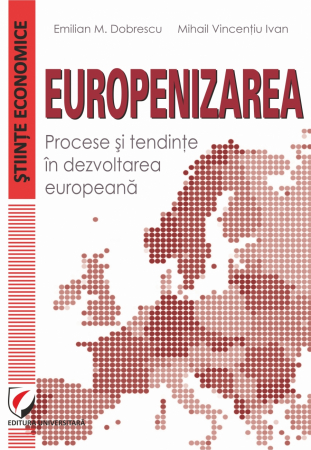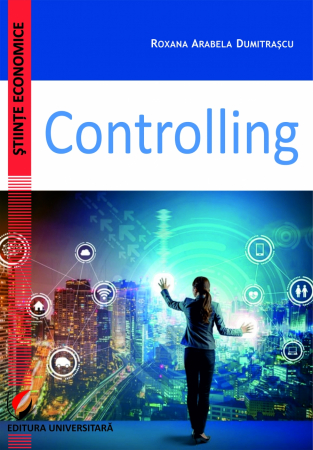Manuscript proposals: info@editurauniversitara.ro / 0745 204 115 //// Tracking orders Individuals / Sales:0745 200 718 / 0745 200 357 Orders Legal entities: 0721 722 783
ISBN: 978-606-591-688-3
DOI: 10/5682/9786065916883
Publisher year: 2013
Edition: I
Pages: 260
Publisher: Editura Universitara
Author: Vadim Dumitrascu
Product Code:
9786065916883
Do you need help?
0745 200 718
/
0745 200 357
- Description
- Download (1)
- Authors
- Content
- More details
- Where to find it
- Reviews (0)
The current universe of organizations is composed of interdependent and interactive variables, which often offer real surprises, not always pleasant. Taylor's vision of organization, according to which the organization is conceived rationally, like a car, in order to perform clear tasks in a stable context, was born in a world dominated by anti-chance and certainty. The mechanistic order had the vocation to tame and structure the disorder of social life. The present is characterized, however, by the emergence of a turbulent and unpredictable world, imposing on organizations, increasingly aggressively, its conditions, trends and solutions. All these represent sources of uncertainty, which motivate the organization to give up the rigidity of a mechanistic regime, protective only in appearance, in favor of suppleness and the ability to adapt to the dynamics of life.
If in the past the key to managerial success lies in subordinating the organization to a logic of the artificial machine, now the efficiency of the organization depends on its ability to manifest itself as a living organism, able to address the disorder of reality. The transition from the frozen order to life, from artificial to live, from mechanistic to biological references, creates a new managerial terminology: polycellular, intelligent, networked organizations or metabiological models of organization or morphogenesis of organizations are just a few such terms. .
Leading and organizing today no longer just means keeping order, but increasingly means "creating life." But life means metabolism, an active exchange of energy, resources and information both inside the body and between it and the environment. This statement is also valid for organizations, suggesting the need to abandon isolationism and managerial protectionism in favor of the idea of interfunctional communication and openness to the environment. It is considered the transition from the policy of organizational construction of the type of protected managerial areas - true internal feuds - to the policy of developing transversal flows of communication and organizational interaction. The transition from a divided and discontinuous organization to a fluid and continuous organization, from the Balkan organization to the organization that encourages flows, relationships, synergies, complementarities and convergences, is in itself an enormous strategic advantage. This change cannot be achieved without a fundamental reconsideration of the sources of power within the economic organizations, implying the transition from the formal-legal authority, received through official regulations, to the acquired power. The time for leadership has come!
In bureaucratic organizations, authority is distributed hierarchically, line managers (middle level) having a power conferred by the formal status or delegated by hierarchical superiors. In an increasingly volatile and unpredictable universe, in which surprise and randomness often offer or confirm success, only the promptness of decision and action ensures performance, and this efficiency is possible only through decentralization.
If in the past the key to managerial success lies in subordinating the organization to a logic of the artificial machine, now the efficiency of the organization depends on its ability to manifest itself as a living organism, able to address the disorder of reality. The transition from the frozen order to life, from artificial to live, from mechanistic to biological references, creates a new managerial terminology: polycellular, intelligent, networked organizations or metabiological models of organization or morphogenesis of organizations are just a few such terms. .
Leading and organizing today no longer just means keeping order, but increasingly means "creating life." But life means metabolism, an active exchange of energy, resources and information both inside the body and between it and the environment. This statement is also valid for organizations, suggesting the need to abandon isolationism and managerial protectionism in favor of the idea of interfunctional communication and openness to the environment. It is considered the transition from the policy of organizational construction of the type of protected managerial areas - true internal feuds - to the policy of developing transversal flows of communication and organizational interaction. The transition from a divided and discontinuous organization to a fluid and continuous organization, from the Balkan organization to the organization that encourages flows, relationships, synergies, complementarities and convergences, is in itself an enormous strategic advantage. This change cannot be achieved without a fundamental reconsideration of the sources of power within the economic organizations, implying the transition from the formal-legal authority, received through official regulations, to the acquired power. The time for leadership has come!
In bureaucratic organizations, authority is distributed hierarchically, line managers (middle level) having a power conferred by the formal status or delegated by hierarchical superiors. In an increasingly volatile and unpredictable universe, in which surprise and randomness often offer or confirm success, only the promptness of decision and action ensures performance, and this efficiency is possible only through decentralization.
-
Leadership and Organizational Culture
Download
VADIM DUMITRASCU
Introduction / 9
Chapter 1
Leadership issues
1.1. What do leaders do and not do the managers of organizations / 13
1.2. Leadership functions / 15
1.3. Leaders and managers: interdependencies and complementarities / 20
1.4. Leadership and organizational positioning / 22
1.5. Leadership as a way of exercising power in organizations / 27
Chapter 2
Leadership as an exercise of influence
2.1. The essence of leadership is influencing / 34
2.2. Organizational influence focuses on changing perceptions / 36
2.3. To influence means to create meanings / 39
Chapter 3
Perverse effects in organizations
3.1. Modern organization: the origin of perversion / 49
3.2. The modern managerial ethos / 57
3.3. The great organizational divorce / 64
Chapter 4
The birth of phobic organizations
4.1. Mechanisms of organizational terror / 73
4.2. Catastrophic scenarios and negative self-perceptions in organizations / 78
4.3. Schismogenetic organization / 83
4.4. Torn organization / 89
Chapter 5
Developing an inspired vision
5.1. Reason and feeling in strategic management / 94
5.2. Zen principles and strategy / 98
5.3. Flexible organization and the "transformational man" / 101
5.4. Vision: systems and people / 110
Chapter 6
Control and modeling of organizational behaviors
6.1. Human behavior as a learning process / 115
6.2. Structuring behaviors according to consequences / 121
6.3. Leaders model behaviors to achieve performance / 127
6.4. Negative and positive reinforcement: some necessary nuances / 131
Chapter 7
Effective managerial processes in support of leadership
7.1. An integrated management model / 136
7.2. Performance evaluation systems (SEP) / 139
7.3. Feedback as a means of regulating behaviors / 146
7.4. General considerations regarding staff motivation / 150
Chapter 8
Organizational culture as a generator of meanings
8.1. Cultural perspectives on the organization / 156
8.2. The dimensions of organizational culture / 159
8.3. Typology of organizational cultures. Influencing factors / 163
8.4. The functions of organizational culture / 168
8.5. Organizational culture as meta-communication / 170
8.6. The relationship between attitudes and behaviors in organizations / 174
Chapter 9
Stimulating organizational learning and knowledge
9.1. Knowledge and competitiveness in modern organizations / 179
9.2. Structuring organizations in the knowledge economy / 184
9.3. Organizations as cognitive systems / 188
9.4. Knowledge and communication in organizations / 191
9.5. Cognitive resources and organizational learning / 194
9.6. Community-organization / 197
Chapter 10
Leadership tools: structures and power
10.1. What are organizational structures / 201
10.2. Types of organizational structures / 207
10.3. Leadership as “horizontal management” / 211
10.4. Decentralization in organizations: the great challenge of leadership / 213
Chapter 11
Change in organizations
11.1. The concept of organizational change / 219
11.2. Strategies for organizational change / 224
11.3. Resistance to change: overcoming tactics / 231
Chapter 12
Mental programming and manipulation in organizations
12.1. Memes and memetics (the science of mental programming) / 235
12.2. Modalities of mental programming / 237
12.3. Mental programming in business / 240
12.4. Building good relationships with external and internal customers / 242
12.5. Psychological mechanisms of manipulation / 243
12.6. Priming-based handling techniques / 245
12.7. Other ways of persuasion / 249
12.8. Manipulation and decisional opacity / 253
Bibliography / 255
Chapter 1
Leadership issues
1.1. What do leaders do and not do the managers of organizations / 13
1.2. Leadership functions / 15
1.3. Leaders and managers: interdependencies and complementarities / 20
1.4. Leadership and organizational positioning / 22
1.5. Leadership as a way of exercising power in organizations / 27
Chapter 2
Leadership as an exercise of influence
2.1. The essence of leadership is influencing / 34
2.2. Organizational influence focuses on changing perceptions / 36
2.3. To influence means to create meanings / 39
Chapter 3
Perverse effects in organizations
3.1. Modern organization: the origin of perversion / 49
3.2. The modern managerial ethos / 57
3.3. The great organizational divorce / 64
Chapter 4
The birth of phobic organizations
4.1. Mechanisms of organizational terror / 73
4.2. Catastrophic scenarios and negative self-perceptions in organizations / 78
4.3. Schismogenetic organization / 83
4.4. Torn organization / 89
Chapter 5
Developing an inspired vision
5.1. Reason and feeling in strategic management / 94
5.2. Zen principles and strategy / 98
5.3. Flexible organization and the "transformational man" / 101
5.4. Vision: systems and people / 110
Chapter 6
Control and modeling of organizational behaviors
6.1. Human behavior as a learning process / 115
6.2. Structuring behaviors according to consequences / 121
6.3. Leaders model behaviors to achieve performance / 127
6.4. Negative and positive reinforcement: some necessary nuances / 131
Chapter 7
Effective managerial processes in support of leadership
7.1. An integrated management model / 136
7.2. Performance evaluation systems (SEP) / 139
7.3. Feedback as a means of regulating behaviors / 146
7.4. General considerations regarding staff motivation / 150
Chapter 8
Organizational culture as a generator of meanings
8.1. Cultural perspectives on the organization / 156
8.2. The dimensions of organizational culture / 159
8.3. Typology of organizational cultures. Influencing factors / 163
8.4. The functions of organizational culture / 168
8.5. Organizational culture as meta-communication / 170
8.6. The relationship between attitudes and behaviors in organizations / 174
Chapter 9
Stimulating organizational learning and knowledge
9.1. Knowledge and competitiveness in modern organizations / 179
9.2. Structuring organizations in the knowledge economy / 184
9.3. Organizations as cognitive systems / 188
9.4. Knowledge and communication in organizations / 191
9.5. Cognitive resources and organizational learning / 194
9.6. Community-organization / 197
Chapter 10
Leadership tools: structures and power
10.1. What are organizational structures / 201
10.2. Types of organizational structures / 207
10.3. Leadership as “horizontal management” / 211
10.4. Decentralization in organizations: the great challenge of leadership / 213
Chapter 11
Change in organizations
11.1. The concept of organizational change / 219
11.2. Strategies for organizational change / 224
11.3. Resistance to change: overcoming tactics / 231
Chapter 12
Mental programming and manipulation in organizations
12.1. Memes and memetics (the science of mental programming) / 235
12.2. Modalities of mental programming / 237
12.3. Mental programming in business / 240
12.4. Building good relationships with external and internal customers / 242
12.5. Psychological mechanisms of manipulation / 243
12.6. Priming-based handling techniques / 245
12.7. Other ways of persuasion / 249
12.8. Manipulation and decisional opacity / 253
Bibliography / 255
The current universe of organizations is composed of interdependent and interactive variables, which often offer real surprises, not always pleasant. Taylor's vision of organization, according to which the organization is conceived rationally, like a car, in order to perform clear tasks in a stable context, was born in a world dominated by anti-chance and certainty. The mechanistic order had the vocation to tame and structure the disorder of social life. The present is characterized, however, by the emergence of a turbulent and unpredictable world, imposing on organizations, increasingly aggressively, its conditions, trends and solutions. All these represent sources of uncertainty, which motivate the organization to give up the rigidity of a mechanistic regime, protective only in appearance, in favor of suppleness and the ability to adapt to the dynamics of life.
If in the past the key to managerial success lies in subordinating the organization to a logic of the artificial machine, now the efficiency of the organization depends on its ability to manifest itself as a living organism, able to address the disorder of reality. The transition from the frozen order to life, from artificial to live, from mechanistic to biological references, creates a new managerial terminology: polycellular, intelligent, networked organizations or metabiological models of organization or morphogenesis of organizations are just a few such terms. .
Leading and organizing today no longer just means keeping order, but increasingly means "creating life." But life means metabolism, an active exchange of energy, resources and information both inside the body and between it and the environment. This statement is also valid for organizations, suggesting the need to abandon isolationism and managerial protectionism in favor of the idea of interfunctional communication and openness to the environment. It is considered the transition from the policy of organizational construction of the type of protected managerial areas - true internal feuds - to the policy of developing transversal flows of communication and organizational interaction. The transition from a divided and discontinuous organization to a fluid and continuous organization, from the Balkan organization to the organization that encourages flows, relationships, synergies, complementarities and convergences, is in itself an enormous strategic advantage. This change cannot be achieved without a fundamental reconsideration of the sources of power within the economic organizations, implying the transition from the formal-legal authority, received through official regulations, to the acquired power. The time for leadership has come!
In bureaucratic organizations, authority is distributed hierarchically, line managers (middle level) having a power conferred by the formal status or delegated by hierarchical superiors. In an increasingly volatile and unpredictable universe, in which surprise and randomness often offer or confirm success, only the promptness of decision and action ensures performance, and this efficiency is possible only through decentralization.
The man on the field, on the front line, where problems arise and are solved or comes into direct contact with the client, must have real power to cope with the assigned tasks. The source of this power is genuine leadership.
The new conditions make it almost impossible or very difficult to approach the future of the company only on the basis of high precision tools. But in an insecure world, people need more than ever stable landmarks. In the postmodern organization such a landmark is represented by the strength and coherence of the leaders' vision regarding the future evolution of the organization. It is a set of goals and values, which have enough motivational power to give daily work a meaning, developing in each manager or employee a taste for progress and improvement. These rules of the game, simple and clear, must allow the integration of the professional life of each member of the organization in its overall evolution, while encouraging the personal development of individuals.
The vision on the future of the organization, declined in ambitious objectives for each subunit, is the expression of values that have the power to ensure the trust of the members in the future perspectives. Their translation into organizational policies and practices, able to govern the daily life, is a condition that can give meaning and vigor to the activity of each member of the organization, motivating and making him responsible. From this angle, the basic mission of organizational leaders is no longer strategic planning, but the search for a meaning, a raison d'etre of the organization.
The organization's openness to the environment is the basic condition of its survival. The economic organization, from predators and profiteers, must become a partner, which knows that its interest in the long run, it determines it to give clients or other actors outside it more than its immediate economic interest dictates. In this context, staff can no longer be treated as a factor of production, which must be managed efficiently based on strictly economic criteria. The staff becomes human capital, becoming a partner. Economic performance is not obtained only with the help of a motivated staff (how simple it would be!), But with the help of personalities. To move from personnel administration to the valorization of people means to recognize the uniqueness and importance of each person of the organization. In fact, this means that the battle fought on the "front" of innovation and quality can only be won when each employee, no matter how modest his position in the organization, wants to do everything better. The central responsibility of leaders is not to give orders or provide incentives, but to create, for each subordinate, depending on their individual tasks, the necessary conditions for them to opt for stronger involvement and personal progress. Beyond simple accountability, it also means "empowering" people, through which everyone becomes the author and actor of their own adventure in the evolution of the organization.
Compensation for loss of order by gaining in dynamism can be achieved by replacing the principle of delegating authority with the principle of subsidiarity, vertical communication with transversal communication, centralism with "multicellular" structures. Building the advantages of a "living" organization, innovative, but at the same time demanding, involves accepting the irreducible contradictions that characterize the internal and external environment of the organization. At present, the art of leadership consists in knowing how to reconcile, without ever reducing, the terms of these contradictions: daily constraints and the needs of the future, the "hierarchical pyramid" and subsidiarity, the need for internal coherence and the search for diversity, unity and autonomy of organizational actors. the solidity of the organization and the flexibility of its elements, stability and action, specialization and interdisciplinarity, the global plans of the organization and the individual plans of its members, total quality through continuous improvements and innovations of rupture, rigor and passion, etc.
Leadership is an art of balancing, of the balanced balance that produces movement, development: an arbitrage, always reconsidered, between order and disorder, which allows achieving high performance in a world where change has become a rule and stability a exception. The organization ceases to be directed, it comes to life, giving up the logic of obedience and embracing the logic of responsibility. The following characteristics of the organization are enhanced:
finality, all people acting in the same direction (the organization's project), finding in it their own values and expectations;
mobilization, achieved through decentralization and participation, which releases the talents, enriching and supporting the members of the organization;
communication, materialized in the preponderance of horizontal, interfunctional interactions and in the continuous improvement of organizational competencies generating quality and innovation.
The culture of an organization is supported by its management systems. It turns out that it is useless to proclaim, within a project of the organization, new values, if the management systems remain unchanged and continue to encourage old motivations, competencies and behaviors. When new orientations in organizational ideology are declared, the systems through which people will be monitored and coordinated must be reviewed, so that the new values and principles are compatible with the administrative mechanisms, which have the function of transposing them into the daily routine. by day. Often, superb and expensive organizational development programs prove inoperable because managers ignore people's real hopes and values. The staff is made up not of standard human units, but of personalities. Through these personalities, with each and together, the performance of the organization is shaped. The members of the organization will be useful only when it will give everyone the opportunity to meet their specific needs for security, self-realization, socialization and recognition.
In order to maintain its competitiveness, the modern organization cannot afford to make savings of ethical reflection and ignore its role in the operating environment or the impact of its mode of action. Because, as I mentioned, life means co-existence, communication and exchange. Leaders are those who transform the organizational machinery into an involved and responsible human community.
If in the past the key to managerial success lies in subordinating the organization to a logic of the artificial machine, now the efficiency of the organization depends on its ability to manifest itself as a living organism, able to address the disorder of reality. The transition from the frozen order to life, from artificial to live, from mechanistic to biological references, creates a new managerial terminology: polycellular, intelligent, networked organizations or metabiological models of organization or morphogenesis of organizations are just a few such terms. .
Leading and organizing today no longer just means keeping order, but increasingly means "creating life." But life means metabolism, an active exchange of energy, resources and information both inside the body and between it and the environment. This statement is also valid for organizations, suggesting the need to abandon isolationism and managerial protectionism in favor of the idea of interfunctional communication and openness to the environment. It is considered the transition from the policy of organizational construction of the type of protected managerial areas - true internal feuds - to the policy of developing transversal flows of communication and organizational interaction. The transition from a divided and discontinuous organization to a fluid and continuous organization, from the Balkan organization to the organization that encourages flows, relationships, synergies, complementarities and convergences, is in itself an enormous strategic advantage. This change cannot be achieved without a fundamental reconsideration of the sources of power within the economic organizations, implying the transition from the formal-legal authority, received through official regulations, to the acquired power. The time for leadership has come!
In bureaucratic organizations, authority is distributed hierarchically, line managers (middle level) having a power conferred by the formal status or delegated by hierarchical superiors. In an increasingly volatile and unpredictable universe, in which surprise and randomness often offer or confirm success, only the promptness of decision and action ensures performance, and this efficiency is possible only through decentralization.
The man on the field, on the front line, where problems arise and are solved or comes into direct contact with the client, must have real power to cope with the assigned tasks. The source of this power is genuine leadership.
The new conditions make it almost impossible or very difficult to approach the future of the company only on the basis of high precision tools. But in an insecure world, people need more than ever stable landmarks. In the postmodern organization such a landmark is represented by the strength and coherence of the leaders' vision regarding the future evolution of the organization. It is a set of goals and values, which have enough motivational power to give daily work a meaning, developing in each manager or employee a taste for progress and improvement. These rules of the game, simple and clear, must allow the integration of the professional life of each member of the organization in its overall evolution, while encouraging the personal development of individuals.
The vision on the future of the organization, declined in ambitious objectives for each subunit, is the expression of values that have the power to ensure the trust of the members in the future perspectives. Their translation into organizational policies and practices, able to govern the daily life, is a condition that can give meaning and vigor to the activity of each member of the organization, motivating and making him responsible. From this angle, the basic mission of organizational leaders is no longer strategic planning, but the search for a meaning, a raison d'etre of the organization.
The organization's openness to the environment is the basic condition of its survival. The economic organization, from predators and profiteers, must become a partner, which knows that its interest in the long run, it determines it to give clients or other actors outside it more than its immediate economic interest dictates. In this context, staff can no longer be treated as a factor of production, which must be managed efficiently based on strictly economic criteria. The staff becomes human capital, becoming a partner. Economic performance is not obtained only with the help of a motivated staff (how simple it would be!), But with the help of personalities. To move from personnel administration to the valorization of people means to recognize the uniqueness and importance of each person of the organization. In fact, this means that the battle fought on the "front" of innovation and quality can only be won when each employee, no matter how modest his position in the organization, wants to do everything better. The central responsibility of leaders is not to give orders or provide incentives, but to create, for each subordinate, depending on their individual tasks, the necessary conditions for them to opt for stronger involvement and personal progress. Beyond simple accountability, it also means "empowering" people, through which everyone becomes the author and actor of their own adventure in the evolution of the organization.
Compensation for loss of order by gaining in dynamism can be achieved by replacing the principle of delegating authority with the principle of subsidiarity, vertical communication with transversal communication, centralism with "multicellular" structures. Building the advantages of a "living" organization, innovative, but at the same time demanding, involves accepting the irreducible contradictions that characterize the internal and external environment of the organization. At present, the art of leadership consists in knowing how to reconcile, without ever reducing, the terms of these contradictions: daily constraints and the needs of the future, the "hierarchical pyramid" and subsidiarity, the need for internal coherence and the search for diversity, unity and autonomy of organizational actors. the solidity of the organization and the flexibility of its elements, stability and action, specialization and interdisciplinarity, the global plans of the organization and the individual plans of its members, total quality through continuous improvements and innovations of rupture, rigor and passion, etc.
Leadership is an art of balancing, of the balanced balance that produces movement, development: an arbitrage, always reconsidered, between order and disorder, which allows achieving high performance in a world where change has become a rule and stability a exception. The organization ceases to be directed, it comes to life, giving up the logic of obedience and embracing the logic of responsibility. The following characteristics of the organization are enhanced:
finality, all people acting in the same direction (the organization's project), finding in it their own values and expectations;
mobilization, achieved through decentralization and participation, which releases the talents, enriching and supporting the members of the organization;
communication, materialized in the preponderance of horizontal, interfunctional interactions and in the continuous improvement of organizational competencies generating quality and innovation.
The culture of an organization is supported by its management systems. It turns out that it is useless to proclaim, within a project of the organization, new values, if the management systems remain unchanged and continue to encourage old motivations, competencies and behaviors. When new orientations in organizational ideology are declared, the systems through which people will be monitored and coordinated must be reviewed, so that the new values and principles are compatible with the administrative mechanisms, which have the function of transposing them into the daily routine. by day. Often, superb and expensive organizational development programs prove inoperable because managers ignore people's real hopes and values. The staff is made up not of standard human units, but of personalities. Through these personalities, with each and together, the performance of the organization is shaped. The members of the organization will be useful only when it will give everyone the opportunity to meet their specific needs for security, self-realization, socialization and recognition.
In order to maintain its competitiveness, the modern organization cannot afford to make savings of ethical reflection and ignore its role in the operating environment or the impact of its mode of action. Because, as I mentioned, life means co-existence, communication and exchange. Leaders are those who transform the organizational machinery into an involved and responsible human community.
www.editurauniversitara.ro
If you want to express your opinion about this product you can add a review.
write a review
Customer Support Monday - Friday, between 8.00 - 16.00
0745 200 718 0745 200 357 comenzi@editurauniversitara.ro
6359.png)
![Leadership and Organizational Culture - Vadim Dumitrascu [1] Leadership and Organizational Culture - Vadim Dumitrascu [1]](https://gomagcdn.ro/domains/editurauniversitara.ro/files/product/large/leadership-si-cultura-organizationala-1375-453872.jpg)

